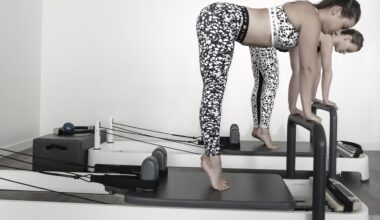How to Use Functional Fitness to Manage Chronic Conditions
Chronic conditions affect millions globally, impacting daily activities and overall quality of life. Functional fitness plays a vital role in managing these challenges effectively. It emphasizes exercises that enhance strength, flexibility, balance, and endurance, which are crucial for performing everyday tasks. Individuals facing chronic conditions often find that traditional exercise routines are not tailored to their needs. Functional fitness programs can bridge this gap by focusing on movements that mimic real-life activities. By integrating these exercises into their routines, individuals can improve resilience, reduce pain, and enhance mobility. Moreover, functional fitness is adaptable. Exercises can be modified depending on a person’s capabilities, ensuring a safe and thoughtful approach to physical activity. For those suffering from conditions like arthritis, diabetes, or cardiovascular issues, it’s especially important to consult healthcare professionals before beginning any new exercise regimen. Alongside these considerations, engaging in functional fitness creates a supportive community. Group classes foster relationships while promoting accountability and motivation, making the exercise experience more enjoyable and sustainable over time.
Functional fitness activities can be structured to target specific health needs. For instance, individuals with arthritis may benefit from low-impact movements that do not place undue stress on joints. Exercises such as seated leg raises or gentle stretches help maintain range of motion and reduce stiffness. Those with cardiovascular concerns should prioritize aerobic activities, incorporating walking or cycling at a comfortable pace. Every session could include strengthening exercises that focus on the core and overall body stability. This holistic approach to exercise not only enhances physical capacity but also contributes to mental wellbeing, alleviating feelings of anxiety or depression often correlated with chronic conditions. Social interactions during functional fitness sessions increase overall joy and resilience. Research indicates individuals engaging in group exercises see marked improvements in their mental health. Furthermore, functional fitness encourages consistency – the key element in managing chronic conditions effectively. Individuals are more likely to stick with physical activity when they enjoy it and feel supported. Incorporating functional activities into daily life equips individuals with the skills needed to navigate everyday scenarios, which builds confidence and reinforces habits beneficial to maintaining their health.
The Benefits of Balance and Flexibility
Balance and flexibility are essential components of functional fitness, particularly for older adults or individuals dealing with chronic conditions. These elements not only improve physical strength but also contribute to better stability and mobility. For those at risk of falls, a focus on enhancing balance can significantly reduce injury potential. Simple exercises such as single-leg stands and tai chi movements promote both balance and coordination. Incorporating stretching routines can maintain flexibility and prevent injury during other physical activities. For those with tight muscles due to inactivity, a regular stretching routine can ease discomfort while enhancing the range of motion. Furthermore, improved flexibility helps in posture correction, reducing strain on joints and muscles. Aging often brings about challenges with mobility and balance, making these aspects even more crucial. Combining balance and flexibility exercises within a functional fitness program fosters independence and self-sufficiency. Seniors who regularly engage in balance and flexibility training often report being more confident in their physical capabilities, leading to increased participation in social activities and reduced feelings of isolation, thus benefiting their overall health.
When crafting a functional fitness regimen, consider incorporating varied types of movement. Such diversity in workouts can address individual needs while keeping sessions engaging. Exercises can be drawn from various disciplines, including strength training, cardio, and mobility work. Progressive overload encourages adaptation, ensuring individuals continually improve without sacrificing their safety. As practitioners grow stronger, increasing resistance or complexity in movements becomes feasible and beneficial. Functional fitness means focusing on practicality; therefore, everyday items may be used as tools for resistance training. Exercises utilizing body weight, resistance bands, or even household objects can be effective and accessible. Establishing routines that incorporate fitness into daily life helps to streamline the process. Encouraging family or friends to participate can further promote adherence, as exercise becomes a shared, enjoyable activity. Additionally, tracking progress through fitness journals or apps can provide motivation and help individuals celebrate their accomplishments. Highlighting achievements, however small, creates a positive reinforcement cycle that encourages continued effort and engagement. Emphasizing incremental progress empowers individuals to embrace their journeys with chronic conditions, facilitating better accountability and sustained commitment to their fitness goals.
Nutrition in Sync with Functional Fitness
Nutrition plays a significant role in conjunction with functional fitness. Proper dietary choices can enhance the efficacy of exercise routines and aid in managing chronic conditions. Foods rich in anti-inflammatory properties—like fruits, vegetables, omega-3 fatty acids, and whole grains—are particularly beneficial for individuals experiencing chronic pain or inflammation. Staying hydrated before, during, and after workouts is equally important, as water supports basic bodily functions and improves performance. Additionally, regular meal times and balanced nutrition improve energy levels, particularly when paired with physical activity. Individuals maintaining a diet focused on nutrient-dense foods often report higher energy and reduced fatigue, making participation in functional fitness more enjoyable. It’s often useful to consult a registered dietitian, especially when managing chronic conditions while exercising. Personalized meal plans can be developed to align with individual health goals and preferences. This collaboration leads to better-informed choices and aligns nutritional intake more closely with fitness objectives, leading to a synergistic effect that promotes overall wellness. A comprehensive approach combining balanced nutrition and functional fitness creates a strong foundation for managing chronic conditions effectively.
Community support can amplify the positive outcomes of functional fitness programs. Engaging in fitness activities with peers fosters an environment of encouragement, accountability, and shared experiences. Many local community centers offer functional fitness classes tailored for individuals with chronic conditions, providing opportunities to learn, grow, and connect. Group exercises can also foster friendships, contributing to increased motivation and reduced feelings of isolation. The social aspect of fitness not only builds community bonds but reinforces commitment to healthier habits. Furthermore, participating in organized sports or events introduces participants to new challenges while fostering camaraderie. Setting collective goals or challenges within a group setting can transform individual pursuits into shared celebrations, enhancing the long-term sustainability of fitness efforts. Community involvement feeds into a cycle of positive reinforcement, encouraging individuals to focus on their capabilities rather than limitations. Being part of a supportive network increases adherence to lifestyle changes that can significantly impact chronic condition management. Thus, fostering community spaces for functional fitness enables individuals to make lasting contributions to their health while simultaneously enriching their social lives.
Conclusion and Encouragement
Functional fitness serves as a remarkable strategy for managing chronic conditions effectively. By enhancing daily life through strength, endurance, balance, and flexibility, individuals can empower themselves against the limitations imposed by their conditions. Tailoring programs to individual needs enables a holistic approach that includes physical activity and supportive nutrition, leading to improved overall health. It is crucial for individuals to introspect and find enjoyment in movement, as enthusiasm for exercise is significantly linked to longevity in healthy habits. The journey may include setbacks, but celebrating progress, no matter how small, is vital for maintaining motivation. Joining group classes or community programs further enriches the experience, providing a framework for camaraderie and shared goals. As awareness of functional fitness grows, resources are becoming more accessible, ensuring everyone can embrace this powerful approach. Focusing on functional fitness not only enhances physical well-being but also improves emotional resilience and mental health. Therefore, individuals are encouraged to start today, seek support, and commit to making functional fitness an integral part of their lives. Doing so will create lasting benefits, ensuring a more active and satisfying future.
This is another paragraph with exactly 190 words…


